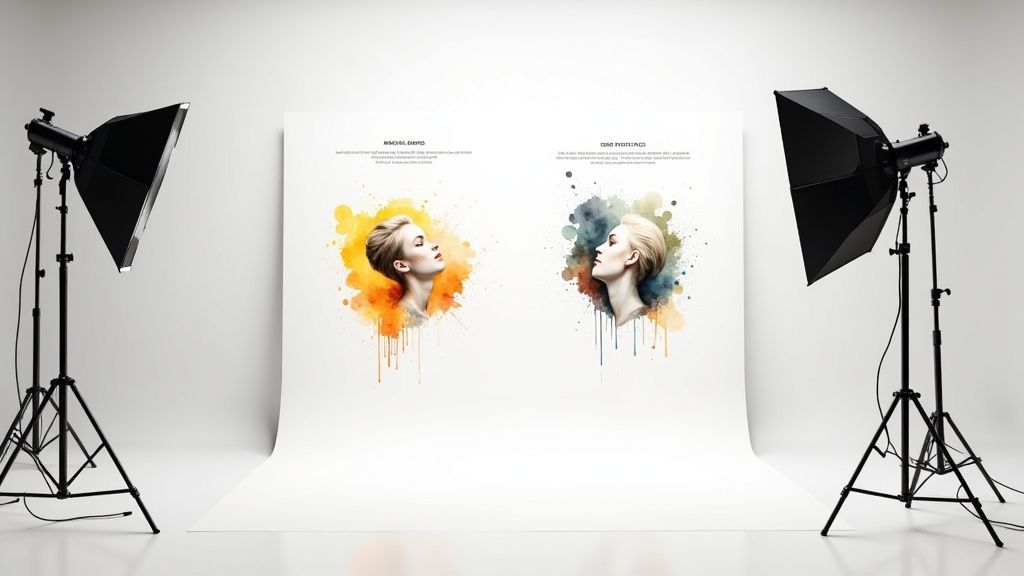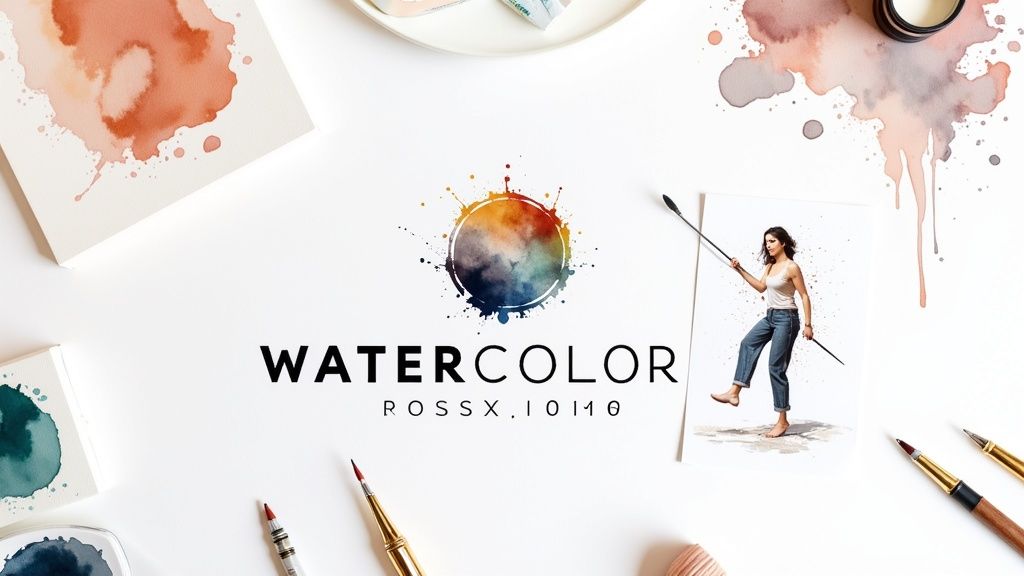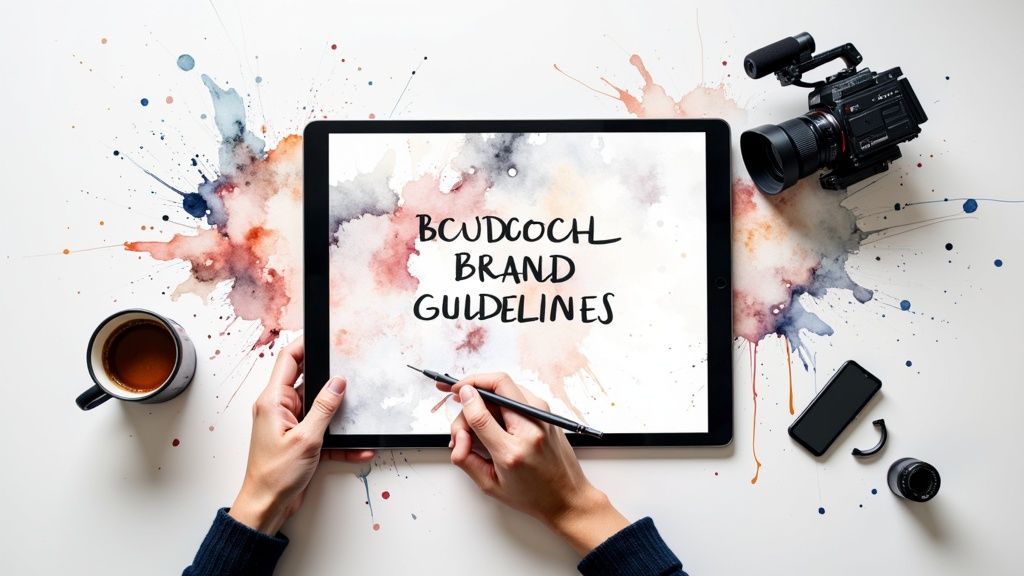In This Article
Subscribe to our newsletter
Why Video Brand Guidelines Are Non-Negotiable Today
Consistent video branding is essential in today's content-saturated world. With so much video content available, brands need a distinct and recognizable presence to build trust and instant recognition with their audience. Imagine watching a video with jarring music, clashing colors, and a tone that doesn't match your expectations of a brand. You might question the video's authenticity and the brand's credibility. This underscores the importance of video brand guidelines in shaping audience perception.
Maintaining visual and tonal consistency strengthens brand identity. Think of it like building a house: each video is a brick, and your brand guidelines are the mortar holding it all together. This creates a unified brand experience, no matter where viewers encounter your videos. Plus, it helps your team scale video production efficiently. When everyone understands the brand's visual and tonal language, content creation becomes smoother, with fewer revisions and consistent quality.
This is especially important because of video's growing dominance. Video brand guidelines are crucial for effective video marketing strategies, particularly as video consumption increases globally. By 2025, an estimated 3.78 billion people worldwide—almost 48% of the global population—will watch digital video content. This shows the massive reach and influence of video. Discover more insights about video marketing statistics. Well-defined video brand guidelines are essential for reaching this vast audience.

The Impact on Brand Perception
Strong video brand guidelines directly influence how your audience perceives your brand. Consistent visuals like your logo, color palette, and typography create a sense of familiarity and professionalism, which builds trust and reinforces your brand message. A technology company, for example, might use sleek visuals and a sophisticated tone of voice to convey innovation and expertise.
Enabling Scalable Content Production
Video brand guidelines are crucial for scalable content production. Imagine a large organization producing videos across different departments. Without clear guidelines, each team might create content with different styles and tones, weakening the overall brand message. With comprehensive guidelines, everyone operates from the same playbook.
This ensures consistency even when multiple teams or external partners are involved. It also allows for quick creation of on-brand content without sacrificing quality. It frees up creative teams to focus on storytelling and innovation within defined parameters. Ultimately, effective video brand guidelines are an investment in your brand's future, ensuring a consistent and impactful presence in the expanding world of video content.
Essential Elements That Make Video Guidelines Work

Effective video brand guidelines are more than just rules about logo placement. They're the blueprint for videos that connect with your audience while staying true to your brand. This means thinking about everything from visuals and sound to the overall message. When these elements work together, your guidelines become a powerful tool for building your brand.
Visual Identity Standards
Visual consistency is key for brand recognition. Your video guidelines should clearly define your visual identity standards. This ensures every video reflects your brand’s personality.
This includes specifying your color palette. Make sure the colors in your videos match your overall brand aesthetic. A nature-focused brand might use earthy tones, while a tech company might choose a modern, minimalist look.
Typography is also important for conveying your brand's message. Specify the fonts for titles, subtitles, and body text to maintain a cohesive look. If you use animation, define styles that fit your brand. This could be smooth transitions for a sophisticated feel or energetic animations for a more playful brand.
Audio Specifications
Just like visuals, consistent audio strengthens your brand. Your video guidelines should address music selection criteria, ensuring the music fits your brand’s tone. Upbeat music might suit a lifestyle brand, while a more serious brand might use classical music.
Your guidelines should also outline sound design principles. This includes specifying sound effects and using them consistently. If you use voiceovers, define the desired characteristics, like tone, pace, and accent. This helps maintain a consistent brand voice.
Content Frameworks and Accessibility
Your video guidelines should go beyond visuals and audio to address the overall content framework. Establish a clear brand voice and ensure all videos follow it. This involves defining the tone, language, and style of your video content.
A brand targeting a younger audience might use informal language and humor, while a professional services firm may use a more formal tone.
To better understand the essential elements that make comprehensive video guidelines, let's look at a table summarizing the key components.
A well-defined set of video brand guidelines can streamline your video production process and ensure consistency across all your video content. This table outlines the key components to include.
| Component Category | Specific Elements | Implementation Examples |
|---|---|---|
| Visual Identity | Color Palette | Use brand colors consistently across all videos. Example: A tech company uses shades of blue and grey. |
| Typography | Define specific fonts for titles, subtitles, and body text. Example: A fashion brand uses a sleek, modern sans-serif font. | |
| Animation Style | Specify animation styles that align with the brand's personality. Example: A children's brand uses bright, playful animations. | |
| Audio Specifications | Music Selection | Choose music that complements the brand's tone and message. Example: A luxury car brand uses orchestral music. |
| Sound Design | Define specific sound effects and ensure consistency. Example: A gaming company uses futuristic sound effects. | |
| Voiceover Characteristics | Specify desired voiceover qualities like tone, pace, and accent. Example: A healthcare brand uses a calm, reassuring voice. | |
| Content Framework | Brand Voice | Establish a clear brand voice and ensure all videos adhere to it. Example: A travel company uses adventurous and inspiring language. |
| Accessibility | Closed Captions | Include closed captions for all videos. Example: Captions are provided in multiple languages. |
| Audio Descriptions | Provide audio descriptions for visually impaired viewers. Example: Detailed descriptions of scenes and actions are included. |
This table provides a framework for creating comprehensive video brand guidelines. By addressing each of these components, you can ensure your videos are consistent, on-brand, and accessible to a wider audience.
Finally, never forget accessibility. Include closed captions and audio descriptions to make your content accessible to everyone. This expands your reach and shows your commitment to inclusivity. By including these essential elements, your team can create high-quality, on-brand videos that resonate with your audience and strengthen your brand identity.
Platform-Specific Guidelines That Actually Perform

Creating effective video brand guidelines means recognizing that each platform is unique. A one-size-fits-all approach won't cut it. You need to understand how your core brand identity translates to platforms like YouTube, TikTok, Instagram, and LinkedIn.
Video's importance in today's content world can't be ignored. It now makes up almost 83% of all global internet traffic. This emphasizes why brands need to prioritize video and use brand guidelines to ensure consistent and professional presentation. Find more detailed statistics here.
Tailoring Content for Specific Platforms
Adapting your video brand guidelines isn't just about resizing. It's about understanding each platform's audience, culture, and technical specs. TikTok's fast-paced, trend-focused nature, for example, demands shorter, more dynamic videos than YouTube, where longer content thrives.
Each platform also has unique features like stickers, filters, and interactive elements. Your guidelines should cover how to use these while keeping your brand intact. Platform-specific templates can offer flexibility while preserving brand recognition.
Managing Aspect Ratios and Duration
Clear guidance on aspect ratios and video length for each platform is essential in your video brand guidelines. On Instagram, you might favor square or vertical videos for feed posts but use landscape for IGTV. Widescreen is usually preferred for YouTube.
Video duration also varies. Short videos under a minute might work for TikTok and Instagram Reels, while longer tutorials or discussions are better suited for YouTube. Clear specifications on length ensure consistency and optimize content for each platform's algorithm.
Platform-Specific Engagement Strategies
Effective video brand guidelines require an understanding of platform-specific engagement. This means knowing how audiences interact on each platform and adjusting your strategy. Professional content performs well on LinkedIn, while entertaining, visually-driven videos are more successful on TikTok.
Your guidelines should address these differences. For instance, encourage interactive features like polls and questions in Instagram Stories, while promoting comments and channel subscriptions on YouTube. For deeper insights, check out this guide on How to master....
This tailored approach lets you maintain a consistent brand presence while adapting to each platform's unique characteristics. Platform-specific guidelines help ensure that every video performs well and contributes to a unified and engaging brand experience. They empower your team to create resonant content on each platform while strengthening your overall brand identity.
Mobile-First Video Guidelines That Drive Engagement

Mobile devices are now the primary way people consume video content. This means your video brand guidelines need to prioritize this critical viewing environment. Leading brands are developing mobile-specific guidelines to ensure their content remains clear, concise, and easily digestible on smaller screens. This move toward a mobile-first video approach requires careful attention to various factors, from video length and captions to sound design.
Optimizing for Mobile Viewing Experiences
Best practices suggest focusing on text size and visual clarity for smaller screens. Text should be easily readable on a mobile device. Videos need to be visually clear and understandable, even on smaller displays. This might involve simplifying complex graphics or using close-up shots to highlight key details. Also, consider orientation preferences. Vertical video has become the standard for mobile viewing.
This is supported by projections showing that by 2025, 42.6% of the global population (around 3.47 billion people) will consume video on mobile. This underscores the importance of mobile-optimized video standards. Explore this topic further.
Mobile Video Duration and Captions
Mobile viewing habits favor shorter video durations. People are simply more likely to watch a short video on their phone compared to a longer one. Your video brand guidelines should outline the ideal length for different types of mobile content. Captioning strategies are also crucial. Many people watch videos on mobile without sound. Accurate and engaging captions ensure your message is delivered even when audio is off. Further reading: 8 Best Text-to-Video Converters to Enhance Your Content Strategy.
Sound Design Considerations for Mobile
While 85% of Facebook videos are watched without sound, effective sound design can still enhance the viewing experience, even when muted. Think about using visual cues and text overlays to compensate for the lack of audio. Incorporating background music can set the mood without being crucial for comprehension.
Adapting to Mobile-First Environments
Top brands are adjusting their video brand guidelines to emphasize vertical formats. Vertical video uses more screen real estate on mobile, creating a more immersive experience. Incorporating thumb-stopping visuals—attention-grabbing elements that capture viewer interest—is key for mobile engagement. Finally, simplified messaging is critical for conveying your message quickly and effectively on the smaller screen.
By prioritizing these mobile-first strategies, your video brand guidelines will ensure your videos effectively resonate with audiences in today's mobile-centric world of video consumption.
Balancing Brand Consistency With Creative Freedom
Maintaining brand consistency across your video content doesn't have to stifle creativity. It's all about finding the sweet spot: the perfect balance between a recognizable brand identity and the freedom to explore new and engaging ideas. Think of your video brand guidelines as a trusted roadmap. They offer direction and guidance, but they also allow for exciting detours and unexpected discoveries along the way. This section will explore how to strike this balance, ensuring your videos are both on-brand and captivating.
Defining Non-Negotiable Brand Elements and Flexible Creative Spaces
The first key step is to clearly define your core brand elements and the areas where creativity can truly flourish. Elements like your logo, color palette, and brand voice are typically non-negotiable. These are the foundational building blocks of your brand identity and should be consistently represented across all your video content.
However, other aspects, such as music selection, visual style, and specific storytelling approaches, offer more flexibility. Allowing for creative exploration in these areas keeps your content fresh, dynamic, and engaging, preventing it from becoming repetitive or predictable. Imagine a cooking show: the core ingredients (your brand elements) remain consistent, but the chef (your creative team) has the freedom to experiment with different flavors and presentation styles (creative expression).
Tiered Guideline Systems: Balancing Flexibility and Brand Identity
Implementing a tiered guideline system is a highly effective strategy. This approach categorizes your videos based on their purpose and target audience, allowing for different levels of creative freedom. For example, a straightforward product demo video might require stricter adherence to brand guidelines than a behind-the-scenes glimpse into your company culture, which allows for a more relaxed and informal approach.
This tiered system recognizes that different videos serve different purposes. A corporate training video, for instance, might prioritize clarity and concise information over stylistic flourishes, while a social media campaign might emphasize creativity and audience engagement above all else. This approach allows for tailored flexibility without ever compromising the core elements of your brand identity.
Evolving Your Guidelines: Staying Fresh Without Losing Brand Equity
It's crucial to remember that your video brand guidelines shouldn't be static. As your brand evolves and the media landscape changes, so too should your guiding principles. Regularly reviewing and updating these guidelines ensures they remain relevant, effective, and adaptable to the ever-shifting trends in video content.
This doesn't mean abandoning the core values that define your brand. Instead, it's about exploring new and innovative ways to express your identity. Think of fashion brands: they consistently maintain their core aesthetic while adapting to seasonal trends and evolving consumer preferences. This approach keeps your brand fresh and exciting, reinforcing your hard-earned brand equity. By embracing these strategies, you can create a framework that empowers your creative teams to produce engaging, innovative videos while always upholding the essential elements of your brand. This balance fosters a vibrant content ecosystem, strengthening your brand presence and deeply resonating with your target audience.
Implementing Guidelines Across Teams and Partners
Successfully implementing video brand guidelines takes more than just creating a document. It requires actively integrating these guidelines into the workflows of everyone involved in video production, from internal teams to external partners. This ensures consistent application, minimizes brand inconsistencies, and maximizes the impact of your video content. This practical guide covers strategies for achieving just that, from documentation formats to training procedures and change management.
Choosing The Right Documentation Format
The format you choose for your video brand guidelines plays a crucial role in how accessible and usable they are. Static PDFs can be a starting point, but consider exploring more interactive options. An interactive PDF with clickable links and embedded video examples can improve engagement. For larger organizations, a dedicated microsite might be even more effective. A microsite acts as a central hub for all brand assets, guidelines, and templates, ensuring everyone has access to the most up-to-date information.
Onboarding and Training: Key To Successful Implementation
A solid onboarding and training program is crucial. For new team members, incorporate guideline training into their initial onboarding. For existing teams and external agencies, conduct regular workshops or training sessions. These refreshers help address any questions or challenges. This proactive approach cultivates a shared understanding of your brand’s visual and tonal identity.
Streamlining The Approval Process
An efficient approval process is essential to prevent bottlenecks and delays. Establish a clear workflow, outlining everyone's roles and responsibilities. A centralized review system, like Frame.io or Wipster, allows videos to be submitted, reviewed, and approved in one place, ensuring alignment with brand guidelines before release. This streamlines quality control without hindering the creative process.
Overcoming Common Implementation Challenges
Implementing guidelines isn't always smooth sailing. Creative resistance can emerge when teams feel their creative freedom is stifled. Address this by clearly explaining the why behind the guidelines, showing how they empower consistent brand storytelling. Version control issues can also cause confusion. A system for managing different versions of the guidelines ensures everyone is on the same page, working with the most recent iteration.
Working With External Partners
Equipping external partners with clear guidelines is vital. Provide user-friendly documentation and offer dedicated training sessions. This upfront investment ensures they understand your brand identity, minimizing revisions and ensuring smooth collaboration. Maintain regular communication and feedback throughout the production process.
Measuring and Improving Guideline Adoption
Measure the effectiveness of your implementation. Track guideline usage and video performance metrics, such as views, engagement, and conversion rates. Regularly gather feedback from internal teams and external partners to pinpoint areas for improvement. This iterative process helps your video brand guidelines remain a valuable tool for creating impactful, consistent video content.
To help visualize the implementation process, consider the following framework:
This table outlines a structured approach for successfully implementing video brand guidelines across different stakeholder groups.
Video Guidelines Implementation Framework
| Stakeholder Group | Implementation Strategy | Training Approach | Common Challenges | Success Metrics |
|---|---|---|---|---|
| Internal Creative Teams | Integrate guidelines into existing workflows and tools. Provide access to templates and brand assets. | Onboarding sessions, regular workshops, and online resources. | Creative resistance, adapting to new processes. | Adherence to brand guidelines, content creation efficiency, improved video performance metrics. |
| Marketing Team | Align video content with marketing campaigns and overall brand strategy. | Training on guideline application for marketing materials and campaigns. | Balancing brand consistency with creative flexibility for different marketing channels. | Increased brand awareness, improved conversion rates, consistent brand messaging across platforms. |
| External Agencies/Partners | Provide clear guidelines and dedicated training sessions. Establish communication channels for feedback and revisions. | Initial onboarding, ongoing support, and access to brand resources. | Understanding brand nuances, aligning creative vision. | Adherence to guidelines, timely delivery of assets, consistent brand representation. |
| Sales Team | Equip with branded video content for sales presentations and client communication. | Training on utilizing video content effectively in the sales process. | Accessing and utilizing the right video assets for different client needs. | Increased sales conversions, improved client engagement, effective use of video content in sales materials. |
This framework highlights the importance of tailored strategies, consistent training, and ongoing measurement for successful implementation. By addressing these key areas, you can ensure your brand’s visual and tonal identity shines through in all your video content, maximizing its impact and reinforcing your brand presence.
Measuring The ROI of Your Video Brand Guidelines
Establishing video brand guidelines is a crucial first step. But how do you measure their impact on your business objectives? It’s essential to move beyond subjective opinions and demonstrate a tangible return on investment (ROI). This means quantifying the effects of your guidelines on key metrics.
These metrics might include brand recognition, audience engagement, and conversion rates. Tracking these key performance indicators (KPIs) reveals the real benefits of consistent video branding.
Key Performance Indicators (KPIs) for Video Brand Guidelines
Several KPIs can illuminate the effectiveness of your video brand guidelines. Brand recognition, for instance, can be tracked by monitoring changes in brand recall and awareness after implementation. Are brand searches increasing? Is your video content being recognized more quickly? These are signs of progress.
Audience engagement is another vital metric. Analyze changes in video views, watch time, likes, shares, and comments. Upward trends in these areas likely indicate a more engaging viewing experience, driven by your guidelines.
Finally, keep a close eye on conversion rates. Are your videos leading to more leads, sales, or sign-ups? This suggests that your branding is resonating with your target audience and contributing to your bottom line.
Tracking Improvements and Gathering Feedback
Implementing video brand guidelines presents a golden opportunity for tracking improvement. Compare video performance metrics before and after implementation. A noticeable uptick in engagement or conversions post-implementation is a strong indicator of success.
Don't neglect qualitative feedback either. Surveys and focus groups offer valuable insights into audience perception of your videos and overall brand experience. Combining quantitative data and qualitative feedback allows for a comprehensive assessment of your guidelines’ effectiveness. You might also be interested in exploring additional Video Content Marketing Strategies That Convert.
Demonstrating Value to Leadership
When presenting the ROI of your video brand guidelines to leadership, quantifiable data is key. Create reports that clearly showcase the impact of consistent branding on important business metrics. For example, if your guidelines led to a 15% increase in brand awareness or a 10% boost in conversion rates, emphasize these wins.
This data-driven approach justifies continued investment in guideline development and refinement. It also underscores the importance of consistent branding in achieving business goals. Consider the UK’s digital video audience: 74.9% of the population (roughly 50.6 million people) regularly viewed digital videos in 2022. The 18- to 24-year-old demographic boasts a 97.2% monthly engagement rate. Read the full research here. This highlights the significance of video brand guidelines for reaching younger audiences.
Industry Benchmarks and Ongoing Refinement
Use industry benchmarks to set realistic performance expectations. Knowing the average performance in your sector provides context for evaluating your own results. It also helps identify areas where your guidelines are particularly successful or need further refinement. Continuously refine your guidelines based on data and feedback. This iterative approach ensures your video brand guidelines remain a valuable tool for enhancing brand recognition, boosting engagement, and maximizing conversions.
Aeon, a video creation platform designed for publishers, helps maintain brand consistency across your video content. By automating and streamlining video production, Aeon ensures all your videos adhere to your established brand guidelines. Learn more at https://www.project-aeon.com.






.jpg)